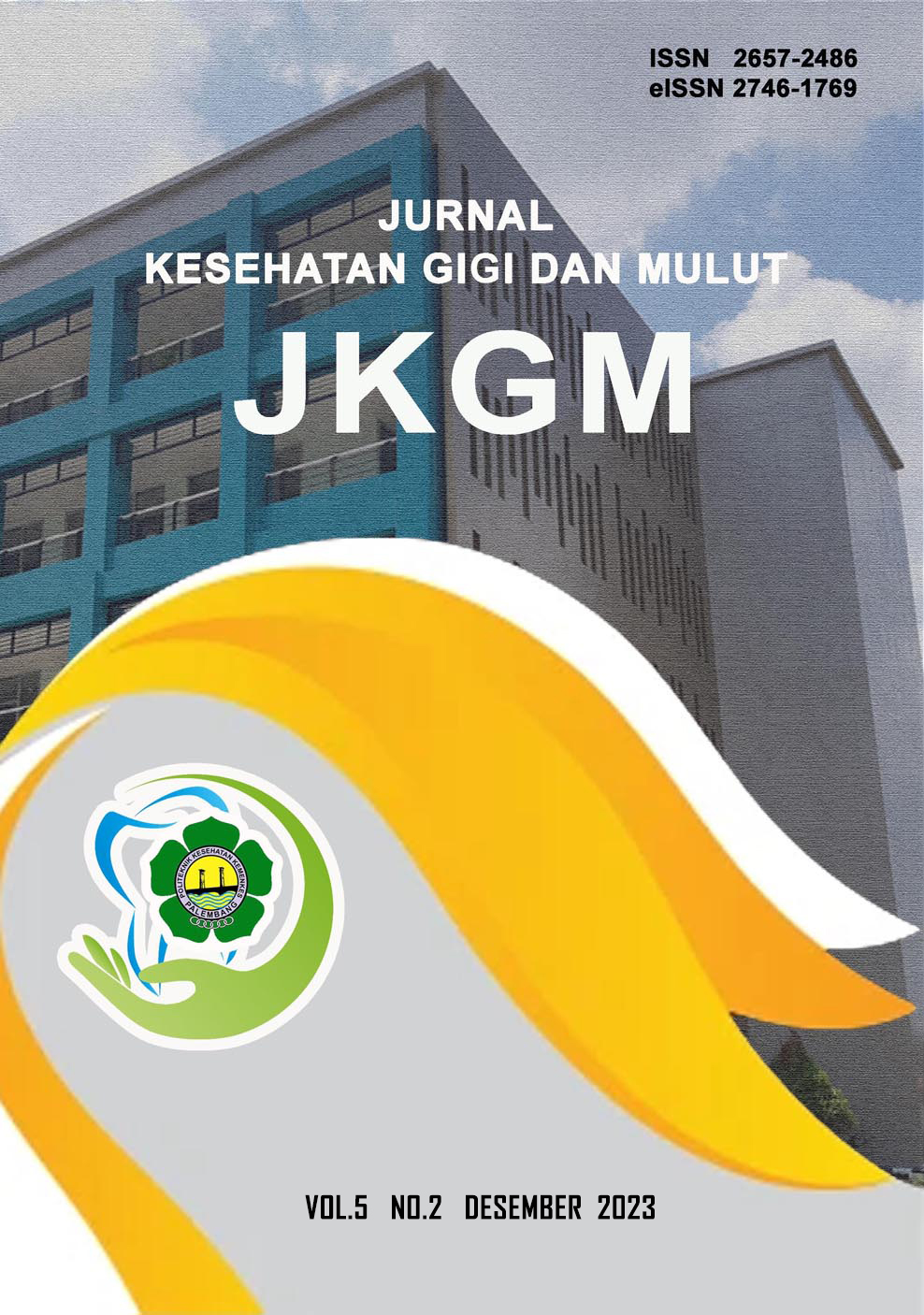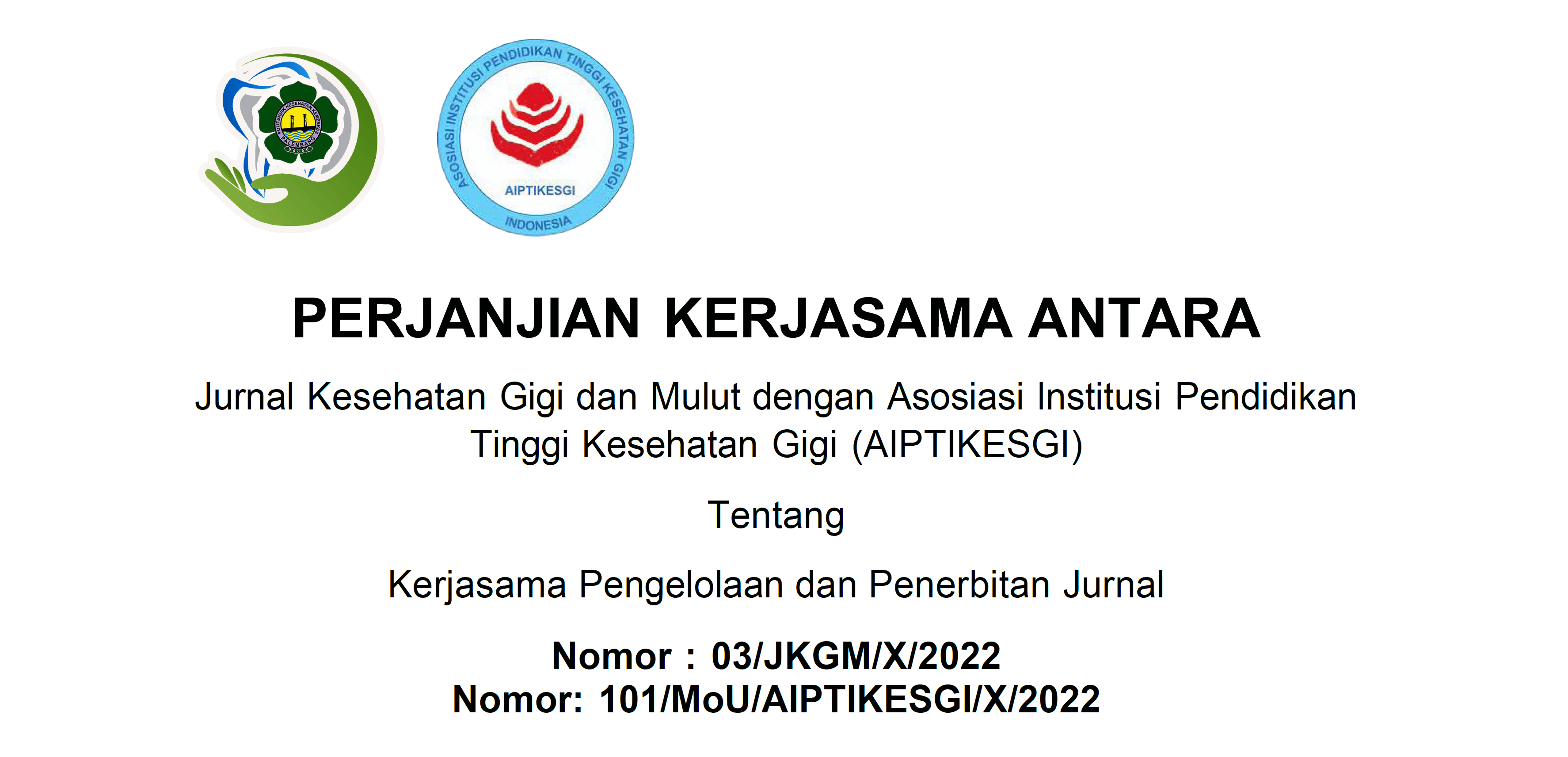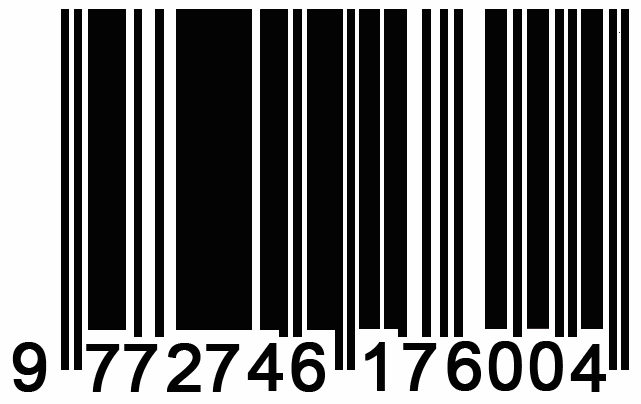Effect of Xylitol, Sorbitol, and Combination Xylitol-Sorbitol Chewing Gum on Increasing Saliva pH
Abstract
Saliva is an important factor in maintaining dental and oral health which plays a role in protective functions. The protective function is carried out by increasing saliva secretion which can be measured through flow speed, volume, pH and viscosity. The aim of this study is to determine the effect of chewing gum containing xylitol, sorbitol, and a combination of xylitol-sorbitol on increasing saliva pH. This research is a quasi-experiment research carried out in March 2022 at the Dental Health Program Study of Health Polytechnic of Palembang. The research sample of 60 people from the Dental Health Department was grouped into three groups. Each group was treated with chewing gum containing two pieces of xylitol, sorbitol, and a combination of xylitol-sorbitol for five minutes. Saliva measurements are carried out using a pH meter. Data were analyzed using a one-way anova test with a 95% confidence interval. The mean salivary pH in each group showed a significant increase (p<0.05). OnThe group that chewed gum containing xylitol had an increase in the mean saliva pH of 1.839, in the group that chewed gum containing sorbitol there was an increase in the mean saliva pH of 1.698, and in the group that chewed gum containing a combination of xylitol-sorbtiol there was an increase in the mean saliva pH of 1.868. There was a significantly increase in the mean pH of saliva in the three groups of subjects after chewing gum (p<0.05), but no significant mean differences were found between treatment groups (p>0.05). Chewing gum containing xylitol, sorbitol, and a combination of xylitol-sorbitol can reduce the risk of dental caries by increasing saliva pH.
References
2. Tridiananda R, Wahyuni S. 2019. Pengaruh mengunyah permen karet berxylitol terhadap pH saliva. JKGM; 1(2), 36–9.
3. Suratri MAL, Jovina TAN, Indirawati T. 2017. Pengaruh (pH) saliva terhadap terjadinya karies gigi pada anak usia prasekolah. Buletin Penelitian Kesehatan; 45(4), 241–8.
4. Nina AH, Siti K, Bayu IS. 2014. Efek pengunyahan permen karet yang mengandung xylitol terhadap peningkatan pH saliva. Dentino Jurnal Kedokteran Gigi; 2(1): 51-54.
5. Somani R, Jaidka S, Singh DJ. 2015. Comparative evaluation of the effect of different types of chewing gums on salivary pH. An in vivo study. IJOCR; 3(7), 45–50.
6. Nuranisyah V, Edi IS, Purwaningsih E. 2021. Nilai pH saliva anak usia sekolah dasar ditinjau dari konsumsi yoghurt dan permen karet xylitol. Jurnal Poltekkes Tasikmalaya, 2(2), 307–313.
7. Ramayanti S, Purnakarya I. 2013. Peran makanan terhadap kejadian karies gigi. Jurnal Kesehatan Masyarakat; 7(2), 89–93.
8. Dewi GK, Susilarti, Almujadi. 2018. Perbedaan pH saliva sebelum dan sesudah mengunyah permen karet xylitol pada pemakai alat orthodonti cekat. Journal of Oral Health Care; 6(1), 15–19.
9. Priyambodo RA, Nurindah. 2018. Pengaruh mengunyah permen karet xylitol terhadap pH saliva perokok. Media Kesehatan Gigi, 17(1), 1–7.
10. Savita A, Sungkar S, Chismirina S. 2017. Perbandingan laju aliran saliva sebelum dan sesudah mengunyah permen karet nonxylitol dan xylitol pada anak usia 10-12 tahun (studi pada murid Sekolah Dasar Negeri 57 Banda Aceh). Journal Caninus Denstistry; 2(2), 65–70.
11. Angwarmase A, Tih F, Hidayat M. 2017. Pengaruh mengunyah permen karet yang mengandung xylitol terhadap volume dan keasaman air liur. Journal of Medicine and Health; 1(5), 471-6,
12. Asmalinda W, Sapada E, Agustin Y. 2021. Peningkatan pH saliva perokok aktif menggunakan permen karet xylitol. Jurnal Kesehatan; 12(3), 427-34.
13. Podunavac I, Hinic S, Kojic S, Jelenciakova N, Radonic V, Petrovic B, Stojanovic G.M. 2021. Microfluidic platform for examination of effect of chewing xylitol gum on salivary pH, O2, and CO2. Appl. Sci.; 11, 2049. https://doi.org/10.3390/app11052049
14. Ismalayani. 2022. Comparison of chewing rubber candy containing xylitol and sorbitol to pH increasing saliva. IJISRT; 7(12), 1731-5.
15. Prihastari L, Putri MA. 2022. The changes in salivary ph by chewing black tea (Camellia sinensis) candy containing the sorbitol. Dentino Jurnal Kedokteran Gigi; 7(2), 210-214.
16. Rafeek R, Carrington CVF, Gomez A, Harkins D, Torralba M, Kuelbs C, Addae J, Moustafa A, Nelson KE. 2018. Xylitol and sorbitol effects on the microbiome of saliva and plaque. Journal of Oral Microbiology; 11, 1-21.
17. Gozali HA, Sianita PP. 2022. The difference in salivary pH on removable orthodontic appliance before and after immersion with sorbitol. Journal of Health and Dental Sciences; 2(2). 317-28.
18. Defri I, Irfansyah A, Sudarsono SN, Saputro EA. Review: Teknologi pembuatan sorbitol dari tepung tapioca dengan proses hidrogenasi katalitik. Atmosphere; 2(2), 8–14.
19. Soesilo D, Santoso RE, Diyatri I. 2005. Peranan sorbitol dalam mempertahankan kestabilan ph saliva pada proses pencegahan karies. Maj. Ked. Gigi. (Dent. J.); 38(1), 25–28.
Copyright (c) 2023 Jurnal Kesehatan Gigi dan Mulut (JKGM)

This work is licensed under a Creative Commons Attribution-ShareAlike 4.0 International License.
Authors who publish with this journal agree to the following terms:
- Authors retain copyright and grant the journal right of first publication with the work simultaneously licensed under a Creative Commons Attribution License that allows others to share the work with an acknowledgement of the work's authorship and initial publication in this journal.
- Authors are able to enter into separate, additional contractual arrangements for the non-exclusive distribution of the journal's published version of the work (e.g., post it to an institutional repository or publish it in a book), with an acknowledgement of its initial publication in this journal.
- Authors are permitted and encouraged to post their work online (e.g., in institutional repositories or on their website) prior to and during the submission process, as it can lead to productive exchanges, as well as earlier and greater citation of published work













